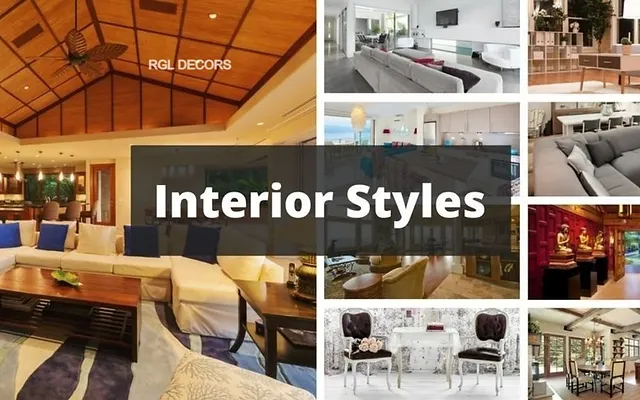Modern:
This style emerged in the early to mid-20th century and is characterized by clean lines, minimalism, and functionality. It often features a neutral color palette, such as whites, grays, and blacks, with occasional pops of bold color. Furniture in modern interiors tends to have sleek, simple designs, often made from materials like metal, glass, and leather. Open floor plans and ample natural light are common features of modern spaces, contributing to an overall sense of spaciousness and airiness.
Traditional:
Traditional interiors draw inspiration from classic European designs, often with a sense of elegance and sophistication. Rich, warm colors like deep reds, greens, and blues are prevalent, along with ornate detailing and luxurious fabrics such as velvet and silk. Furniture tends to be more formal, with pieces like wingback chairs, tufted sofas, and intricately carved wood tables. Traditional interiors often incorporate elements like crown molding, wainscoting, and chandeliers to add to the overall grandeur of the space.
Industrial:
Inspired by the raw, utilitarian aesthetic of urban lofts and warehouses, industrial interiors embrace unfinished materials and exposed structural elements. Brick walls, concrete floors, and metal accents are common features, lending a rugged and edgy vibe to the space. Furniture often has a reclaimed or repurposed look, with pieces made from salvaged wood and distressed metal. Industrial interiors may also incorporate elements like vintage signage, factory-style lighting, and mechanical-inspired decor to further enhance the industrial aesthetic.
Scandinavian:
Originating in the Nordic countries, Scandinavian interiors are known for their simplicity, functionality, and emphasis on natural light. Light, muted colors such as whites, grays, and pastels dominate the color palette, creating a sense of brightness and airiness. Furniture tends to have clean lines and minimal ornamentation, with an emphasis on natural materials like wood and leather. Cozy textiles such as sheepskin rugs and knit throws add warmth and texture to the space, while plants and natural elements bring a touch of the outdoors inside.
Bohemian:
Bohemian interiors are eclectic and vibrant, drawing inspiration from a variety of cultures and design styles. Bold colors, mixed patterns, and layered textiles create a sense of warmth and coziness, while vintage and handmade items add character and charm. Furniture in bohemian interiors often has a relaxed, lived-in look, with pieces like overstuffed sofas, floor cushions, and Moroccan poufs. Plants and natural materials like rattan and jute are also common features, adding to the earthy and organic feel of the space.
Mid-Century Modern:
This style emerged in the mid-20th century and is characterized by clean lines, organic shapes, and a focus on functionality. Mid-century modern interiors often feature iconic furniture designs from the period, such as Eames lounge chairs, Saarinen tulip tables, and George Nelson clocks. A neutral color palette with pops of vibrant accent colors is typical, along with natural materials like wood and fiberglass. Sleek, minimalistic forms and geometric patterns are also common features of mid-century modern design.
Coastal:
Coastal interiors are inspired by the relaxed and casual atmosphere of beachside living. Light, airy colors such as whites, blues, and sandy neutrals dominate the color palette, evoking the colors of the sea and sky. Natural materials like rattan, wicker, and weathered wood are common in coastal interiors, along with nautical-inspired accents like rope, shells, and stripes. Furniture tends to be comfortable and casual, with plush sofas, oversized armchairs, and breezy curtains that allow for plenty of natural light.
Rustic:
Rustic interiors celebrate the charm and simplicity of rural living, with an emphasis on natural materials and textures. Exposed wood beams, reclaimed barnwood, and stone accents create a warm and inviting atmosphere, while earthy colors like browns, greens, and terra cottas evoke a sense of the outdoors. Furniture in rustic interiors often has a handmade or artisanal quality, with pieces like farmhouse tables, distressed leather sofas, and wrought iron fixtures. Cozy textiles like wool blankets and plaid cushions add to the comfort and warmth of the space.
| "BEST BUILDER FLOOR APARTMENT IN CHENNAI" |
Minimalist:
Minimalist interiors are characterized by simplicity, clarity, and a focus on essential elements. Clean lines, neutral colors, and uncluttered spaces create a sense of calm and tranquility, while carefully chosen furnishings and decor pieces contribute to a sense of purpose and intentionality. Furniture in minimalist interiors tends to be sleek and understated, with an emphasis on functionality and practicality. Storage solutions are often integrated seamlessly into the design, helping to maintain a clean and clutter-free environment.
Art Deco:
Originating in the 1920s and 1930s, Art Deco interiors are glamorous, luxurious, and characterized by bold geometric shapes, rich colors, and ornate detailing. Opulent materials like marble, brass, and lacquered wood are common in Art Deco design, along with luxurious fabrics such as velvet and silk. Furniture often features streamlined silhouettes and sleek, polished finishes, with decorative elements like inlaid patterns and metallic accents adding to the overall sense of elegance and sophistication.
Shabby Chic:
Shabby Chic interiors have a vintage-inspired aesthetic with a soft, romantic feel. Distressed furniture, faded fabrics, and chipped paint create a sense of history and nostalgia, while pastel colors like blush pink, soft blue, and creamy white contribute to a sense of lightness and femininity. Furniture in Shabby Chic interiors tends to have a weathered and worn look, with pieces like slipcovered sofas, vintage dressers, and antique mirrors adding to the overall charm and character of the space.
Mediterranean:
Inspired by the coastal regions of Southern Europe and North Africa, Mediterranean interiors are warm, inviting, and full of character. Earthy colors like terracotta, ochre, and olive green dominate the color palette, while natural materials like stone, clay, and wrought iron create a sense of rustic elegance. Furniture in Mediterranean interiors often features ornate detailing and intricate carvings, with pieces like wrought iron bed frames, tiled tables, and upholstered armchairs adding to the overall richness and texture of the space.
Eclectic:
Eclectic interiors are all about mixing and matching different styles, periods, and cultural influences to create a unique and personalized look. Bold colors, mixed patterns, and unexpected combinations of materials and textures are common in eclectic design, resulting in spaces that are dynamic, vibrant, and full of personality. Furniture in eclectic interiors can range from antique heirlooms to contemporary designer pieces, with each item contributing to the overall eclectic aesthetic in its own way. Artwork, accessories, and decorative accents play a crucial role in tying together the diverse elements of eclectic design, adding layers of visual interest and complexity to the space.
Japanese Zen:
Inspired by traditional Japanese design principles, Zen interiors are serene, minimalist, and focused on creating a sense of harmony and tranquility. Clean lines, natural materials, and a subdued color palette create a sense of simplicity and calm, while carefully curated furnishings and decor items contribute to a sense of balance and order. Furniture in Zen interiors tends to be low to the ground and unobtrusive, with an
https://www.livehomes.in/blogs













